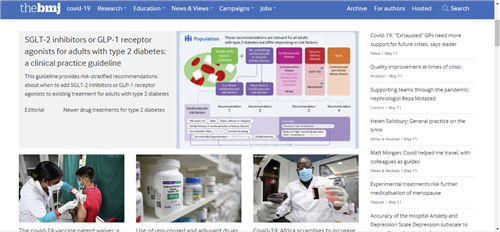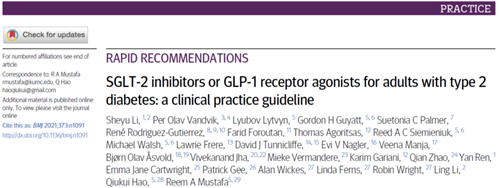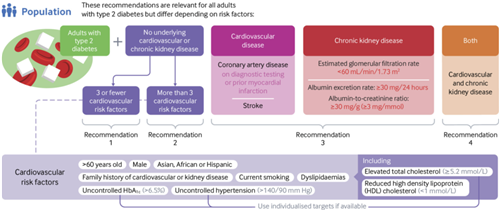WCH led International Clinical Practice Guideline for Pharmacotherapy of Type 2 Diabetes on The BMJ as cover story

On May 11, 2021, The BMJ (IF: 30.223) published an international clinical practice guideline for pharmacotherapy of type 2 diabetes as cover story regarding two novel antidiabetic drugs, say SGLT-2 inhibitors and GLP-1 receptor agonists. Dr Sheyu Li, from Department of Endocrinology and Metabolism of WCH led the guideline as clinical co-chair with Dr Reem A Mustafa of University Kansas Medical Centre. Dr Qiukui Hao from the Geriatrics Centre of WCH contributed as method chair. The guideline also involved 28 multidisciplinary panel members from 11 countries practising as endocrinologists, nephrologists, cardiologists, internists, general practitioners, geriatricians, methodologists and patient partners . Dr Li drafted the guideline and was authored the first place with Dr Hao and Dr Mustafa as the co-corresponding authors.

Adopting the latest evidence and novel approach, the guideline guided the clinical use of the SGLT2 inhibitors and GLP-1 receptor agonists in the perspective of adults living with type 2 diabetes with global sight. The panel stratified people with type 2 diabetes into five layers according to their baseline risk of cardiovascular and kidney prognosis. The guideline provided five recommendations by evaluating the absolute benefits and harms of the two antidiabetic drugs in people of different layers. The guideline platform, say The BMJ journal and MAGICapp, facilitates the shared decision-making using interactive online tools.

Prof Steven M Smith from University of Florida highly appraise the practice-changing potential of this guideline in the accompanying editorial in The BMJ. Diabetes Research and Clinical Practice, the official journal of International Diabetes Federation, shortly released a report by Taskforce of the Guideline Workshop 2020 lead Prof Nikolaus Marx from University Aachen and top clinical diabetologists from ten countries and regions. The document affirmed the development process of this guideline and how it may help the clinicians and patients in its easy-to-use manner. The guideline was later translation into Chinese in the Chinese version of The BMJ, and interpreted in Chinese journals. This is the first international clinical practice guideline for type 2 diabetes that was led by clinicians from mainland China as the clinical chair. It is also the first landmark since the establishment of MAGIC China Centre and Department of Guideline and Rapid Recommendation in Chinese Evidence-based Medicine Centre of WCH.
Link: https://www.bmj.com/content/373/bmj.n1091


